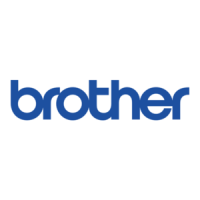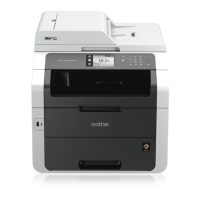
Do you have a question about the Brother MFC-9325CW and is the answer not in the manual?
| DVD/CD printing | No |
|---|---|
| Print technology | LED |
| Maximum resolution | 2400 x 600 DPI |
| Economical printing | Yes |
| Print speed (black, normal quality, A4/US Letter) | 19 ppm |
| Fax compatibility | ITU-T G3 |
| Dimensions (WxDxH) | 429.3 x 490.2 x 391.8 mm |
| All-in-one functions | Copy, Fax, Print, Scan |
| Connectivity technology | Wired & Wireless |
| Display number of colors | Monochrome |
| Color all-in-one functions | copy, fax, print, scan |
| Printing colors | Black, Cyan, Magenta, Yellow |
| Maximum duty cycle | 25000 pages per month |
| Recommended duty cycle | 1500 pages per month |
| Number of print cartridges | 4 |
| Page description languages | BR-Script 3, PCL 6 |
| Copier resize | 25 - 400 % |
| Maximum copy resolution | - DPI |
| Maximum number of copies | 35 copies |
| N-in-1 copy function (N=) | 2, 4 |
| Copy speed (black, normal quality, A4) | 19 cpm |
| Scan to | CIFS, E-mail, File, FTP, Image, OCR, USB |
| Scanner type | Flatbed scanner |
| Input color depth | 48 bit |
| Maximum scan area | A4 / Letter (216 x 297) mm |
| Maximum scan resolution | 19200 x 19200 DPI |
| Optical scanning resolution | 1200 x 2400 DPI |
| Fax memory | 600 pages |
| Modem speed | 33.6 Kbit/s |
| Fax coding methods | JBIG, JPEG, MH, MMR (Fax coding method), MR |
| Fax transmission speed | 2 sec/page |
| Paper input type | Paper tray |
| Total input capacity | 250 sheets |
| Total output capacity | 100 sheets |
| Total number of input trays | 2 |
| Multi-Purpose tray input capacity | 1 sheets |
| Maximum print size | 216 x 356 mm |
| Paper tray media types | Bond paper, Envelopes, Labels, Plain paper, Recycled paper |
| ISO A-series sizes (A0...A9) | A4, A5, A6 |
| ISO B-series sizes (B0...B9) | B5 |
| Maximum ISO A-series paper size | A4 |
| Display | LCD |
| Market positioning | Business |
| Standard interfaces | Ethernet, USB 2.0, Wireless LAN |
| USB 2.0 ports quantity | USB 2.0 ports have a data transmission speed of 480 Mbps, and are backwards compatible with USB 1.1 ports. You can connect all kinds of peripheral devices to them. |
| Wi-Fi standards | 802.11b, 802.11g |
| Supported network protocols (IPv4) | ARP, RARP, BOOTP, DHCP, APIPA(Auto IP), WINS/NetBIOS name resolution, DNS Resolver, mDNS, LLMNR responder, LPR/LPD, Custom Raw Port/Port9100, IPP/IPPS, FTP Client and ServerTELNET Server, HTTP/HTTPS server, TFTP client and server, SMTP Client, APOP, POP before SMTP, SMTP-AUTH, SNMPv1/v2c/v3, ICMP, LLTD responder, WebServicesPrint, CIFS Client, SNTP, SSL/TLS |
| Supported network protocols (IPv6) | NDP, RA, DNS resolver, mDNS, LLMNR responder, LPR/LPD, Custom Raw Port/Port9100, IPP/IPPS, FTP Client and Server, TELNET Server, HTTP/HTTPS server, TFTP client and server, SMTP Client, APOP, POP before SMTP, SMTP-AUTH, SNMPv1/v2c/v3, ICMPv6, LLTD responder, WebServicesPrint, CIFS Client, SNTP, SSL/TLS |
| Maximum internal memory | 576 MB |
| Sound power level (standby) | 30 dB |
| Sound pressure level (copying) | 53 dB |
| AC input voltage | 120 V |
| AC input frequency | 50 - 60 Hz |
| Power consumption (standby) | 75 W |
| Power consumption (PowerSave) | 12 W |
| Power consumption (average operating) | 480 W |
| Package weight | 28490 g |
| Operating relative humidity (H-H) | 20 - 80 % |
Explains how to use the user guide effectively.
Details symbols and conventions used throughout the documentation.
Guides on accessing supplementary software and network manuals.
Describes the layout and function of the machine's control panel keys.
Explains the meaning of the Data LED status lights.
Instructions on how to load paper and other print media into the machine.
Step-by-step guide for loading paper into the main paper tray.
Instructions for feeding paper or special media via the manual slot.
Details the areas on a page that cannot be printed on by the machine.
Lists the types of paper and media compatible with the machine.
Guidelines for using special paper types like envelopes and labels.
Instructions for loading documents into the ADF or onto the scanner glass.
Sets the time before the machine returns to default fax mode.
Configures paper type and size for optimal print quality.
Adjusts ring, beeper, and speaker volumes for the machine.
Allows manual adjustment of the machine's clock for daylight saving.
Settings for power saving and toner conservation.
Adjusts the contrast of the LCD screen for better readability.
Sets a prefix number to automatically dial before outgoing faxes.
Restricts access to machine functions for different user modes.
Establishes the administrator password for security settings.
Procedure to change the existing administrator password.
Configures a mode with limited functions for public access.
Creates user accounts with specific function restrictions and passwords.
Enables or disables the Secure Function Lock feature.
Allows switching between restricted users or public mode.
Prevents unauthorized access to machine operations while memory is active.
Prevents accidental changes to machine settings by requiring a password.
Prevents sending faxes to wrong numbers via dial pad, One Touch, or Speed Dial.
Basic steps to initiate a fax transmission from the machine.
Instructions for sending faxes using the Automatic Document Feeder.
Instructions for sending faxes using the flatbed scanner glass.
Adjusts scanner settings for Letter size documents to prevent missing content.
Procedure to stop an active fax transmission.
Sending a single fax message to multiple destinations.
Covers advanced sending features like multiple settings and cover pages.
Information on automatically sending a cover page with faxes.
Adjusts contrast for better fax quality on light or dark documents.
Sets the resolution for outgoing faxes to improve quality.
Allows scanning while sending or receiving faxes or printing PC data.
Sends faxes immediately without using memory, useful for important documents.
Stores faxes in memory to be sent within a 24-hour period.
Manages and cancels fax jobs stored in the machine's memory.
Explains different modes for receiving faxes and calls automatically.
Configures settings like Ring Delay and F/T Ring Time for receiving modes.
Enables automatic fax reception even if a call is answered manually.
Covers printing reduced faxes and setting receive stamps.
Manages received faxes stored in memory when paper is low.
Discusses features like Voice Mail and their interaction with the machine.
Allows receiving faxes and voice calls on separate numbers via one line.
Telecom service for additional numbers with distinctive ringing.
Instructions for connecting an external telephone answering device.
Information on operating the machine with external or extension phones.
Enables remote access and control of machine functions via phone.
Explains the different methods for dialling numbers on the machine.
Stores numbers for quick dialling using dedicated keys.
Stores numbers for quick dialling using a three-digit code.
Alphabetically searches stored One Touch and Speed Dial numbers.
Automatically redials the last fax number if the line is busy.
Details on storing numbers for One Touch, Speed Dial, and Groups.
Step-by-step guide to storing numbers on One Touch keys.
Step-by-step guide to storing numbers in Speed Dial locations.
Procedure to modify or delete stored One Touch and Speed Dial numbers.
Organizes contacts into groups for sending the same fax to multiple recipients.
Switching between Tone and Pulse dialling modes.
Automatically forwards received faxes to another machine or email.
Stores received faxes in memory for retrieval from another location.
Stores received faxes in memory and sends them to your PC.
Modifies settings for remote fax options like fax forwarding or storage.
Deactivates all remote fax options and returns machine to default settings.
Accesses stored fax messages remotely using a touch-tone phone.
Sets a personal four-digit code to access remote retrieval features.
Steps to retrieve stored fax messages remotely from the machine.
Modifies the default fax forwarding number remotely.
Lists commands for accessing features remotely via phone.
Information on setting up and printing fax verification and journal reports.
Prints a report confirming fax transmission success or failure.
Lists information about incoming and outgoing faxes.
Lists available reports like Help List, Tel Index, User Settings, etc.
Instructions on printing various reports from the machine.
Basic steps to perform copying operations on the machine.
Procedure for making a single copy of a document.
Instructions for making multiple copies of a document.
Quickly change copy settings temporarily for the next copy.
Adjusts the size of the copied image using enlargement or reduction ratios.
Sets copy settings like Stack/Sort, Brightness, Contrast, and Page Layout.
Adjusts settings like Auto, Photo, or Text for better copy quality.
Stacks or sorts multiple copies when using the Automatic Document Feeder.
Fine-tunes contrast, colour, and brightness for copies.
Reduces paper usage by copying multiple pages onto one sheet.
Handles situations where the machine's memory is full during copying.
Essential points to remember before connecting a camera.
Lists necessary items and conditions for PictBridge printing.
Guides on connecting and setting up a camera for direct printing.
Ensures the camera is in PictBridge mode and configures settings.
Steps to print photos directly from a PictBridge compatible camera.
Printing photos with security features enabled on the MFC-9325CW.
Prints images based on Digital Print Order Format settings from the camera.
Connects the camera as a normal storage device for printing photos.
Troubleshooting common errors encountered during PictBridge printing.
Steps to create print files for direct printing from applications.
Instructions for printing files directly from a USB flash drive.
Printing from USB drive when security features are enabled.
Troubleshooting common errors encountered during USB direct printing.
Covers important safety, legal, and regulatory information for product use.
Information on optional hardware like memory boards and their installation.
Provides solutions for common problems and guides for machine maintenance.
Details the machine's menu structure, navigation, and feature settings.
Lists the technical specifications of the machine's hardware and capabilities.
Defines terms and features commonly found in Brother manuals.











